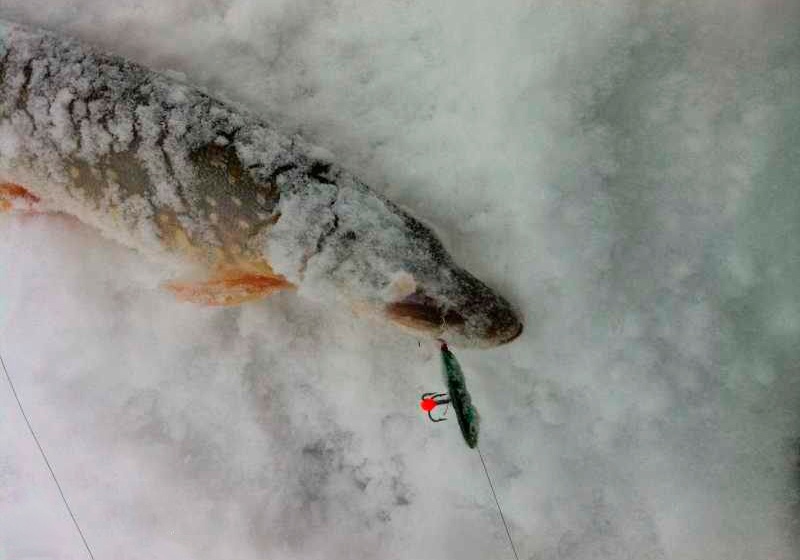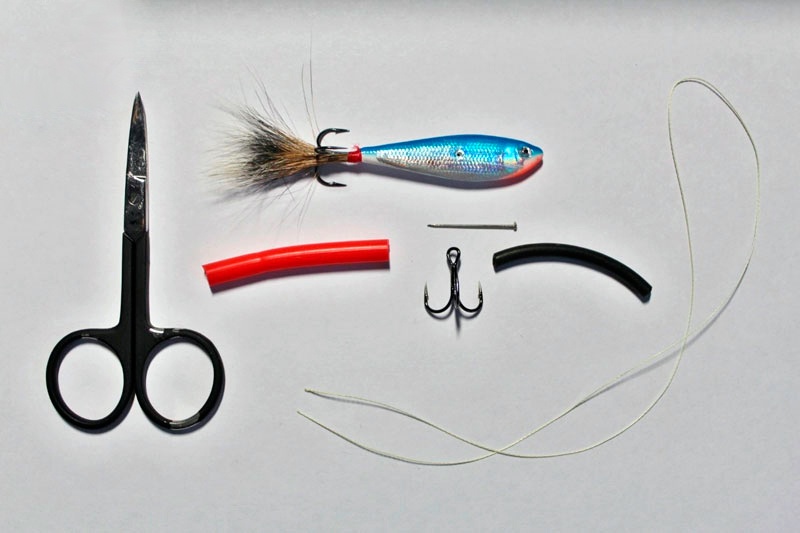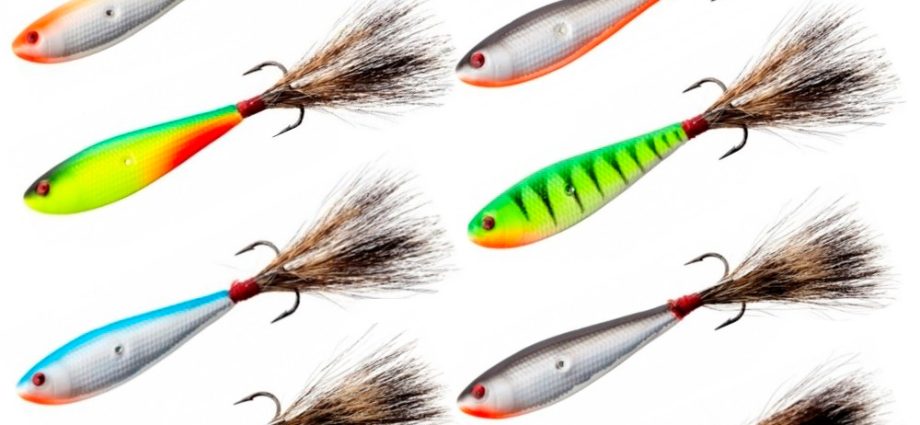Contents
Fishing is considered the favorite pastime of most men. At the same time, many fishermen believe that the main attribute of the fishing process is the bait for fish. Modern shops for fishermen offer a wide range of baits, including artificial ones. A special place among them is fishing for amphipods, which anglers also call the Wasp.
The amphipod is successfully used for pike perch, but it also works well for other predatory fish: pike and perch. You can fish with amphipods both in winter from the ice and in summer in a plumb line from a boat.
What is an amphipod?
Amphipod is a lure that is used for sheer fishing during ice fishing in winter. Such a bait appeared a long time ago and was known to fishermen even before the appearance of balancers. This type of artificial spinner should not be confused with crustacean or mormysh, they have nothing in common with each other.

Photo: Amphipod Lucky John Ossa
The spinner received this name because of its imitation of a fish and a characteristic game during posting. The amphipod makes movements in the horizontal plane of the water, while due to its unusual shape it seems that it is moving sideways. If you properly prepare the tackle, when the lure is attached under an oblique suspension to the main line, then no other winter bait will give such a result as amphipod. It has the following properties:
- The amphipod performs circular movements with a wave of the fishing rod, while imitating the movements of a fry trying to get away from a predator.
- It circulates around the main line when fishing by mormyshing.
- Amphipod performs characteristic movements in the horizontal plane due to the shifted center of gravity and the specific shape of the bait.
- The spinner is effective both when catching passive fish and active perches.
Amphipod fishing: features of ice fishing
The amphipod lure is most often used for ice fishing, but it can also be used for open water fishing. Initially, the amphipod was invented for catching pike perch in the winter, but other predators, including pike, also peck at the bait. This lure can also be used to fish perch and bersh off the ice. Compared to the balancer, the amphipod has more opportunities for catching nimble fish.

Ice fishing for pike on amphipods
Catching pike with amphipods can be quite troublesome, as a toothy predator often injures fishing lines after repeated cuts. The lateral tilt when playing the amphipod has a fascinating effect on the pike, since its slow play and circular movements are much more attractive to the pike than the work of other balancers. In the process of catching pike, she quite often cuts off amphipods, especially dark shades, since outwardly they resemble fish that a predator hunts.
For ice fishing, large amphipods up to 7 mm thick are most often used. If a fish is caught on the rear tee, then the metal leash begins to deform during hooking exactly in the place where the bait is equipped with a hole. If this situation is repeated repeatedly, then soon the fishing line becomes unusable, and this will lead to the loss of fish and even the amphipod itself, since the deformed parts change the suspension and worsen the game of the bait.
When catching large fish like pike, experienced anglers recommend pre-drilling the hole in the amphipod, so that the suspension will suffer less.
Installation of amphipod for winter fishing
When catching pike, the amphipod is usually suspended from the line with the convex side up, otherwise it loses its sweep and can only attract a passive predator. In this state, the bait rotates when shaken and makes circles when swung, attracting active fish. 
In order to collect catchy gear, you need to pay attention to some elements:
- In case the fisherman prefers tackle with a curved handle, a soft whip should be chosen. This will allow you to make a good undercut with a wrist movement of the hand. If the rod is straight, then you need to pick up a fishing rod about 50-60 cm long and a hard whip.
- If the angler chooses a monofilament, then its diameter should be 0,2-0,25 mm. You also need to choose a coil.
- If the fish is large, you need to pick up a metal leash no more than 50 cm long.
The installation of the amphipod is carried out as follows:
- First you need to thread the line through the hole in the bait.
- Between the knot and the bait, it is necessary to lay a damper by stringing a ball or bead on the fishing line.
- Next, an additional tee with colored cambric is tied for a ring pre-dressed on it.
- If such a tee is not used, then you need to install a swivel on the end of the fishing line, which will keep it from twisting. Next, you need to thread the metal leash through the hole in the amphipod and attach it to the standard hook. After the swivel is attached to the leash, the installation of the amphipod can be considered complete.
Video: How to tie an amphipod for winter fishing
Fishing for amphipods in winter and its equipment in the video below:
Tackle for fishing on amphipod and its equipment
As a rod, any fishing rod for winter lure is suitable. It can be both with a nod and without it. Such a tackle is very similar to a reduced copy of a spinning rod.
Most amphipods are made of tin or lead and are shaped like small fish, usually with one convex side. The lure even has a tuft of wool or feather tail to help camouflage the hook and also make it look realistic and attract fish.
The winter amphipod is usually larger, reaches 5-6 cm in length and weighs about 20 grams. For greater safety of the equipment, it is better to use a fluorocarbon leader than a regular monofilament. This is necessary to prevent chafing of the fishing line on the bait, otherwise the tackle may be damaged. The length of such a leash should be at least 20 cm, and the diameter should be about 3-4 mm.
A triple hook is also used to create tackle for the amphipod. The fishing line is passed through the hole of the amphipod and attached to the ring with an additional tee, due to which the center of gravity shifts, and the amphipod works as a horizontal balancer.
Amphipod fishing: fishing technique and tactics
Winter fishing for a predator with amphipods can be successful due to some conditions, including the choice of fishing location and wiring technique. In winter, pikes are usually found in places where the depth of the river and the turn abruptly change, as well as in the blockages of snags. Fish are usually found in those places where the concentration of oxygen is maximum. There are almost no predators in places with a weak current. Closer to spring, predators come closer to the shore, to the place where melt water accumulates, where their food base tends to.

There are several ways to catch pike on amphipods – stepped, winter lure, shaking, pulling, tossing and others. For each of them, you need to pick up separate movements that you can work out at home in the bathroom, and already practice in the pond.
- Stepped wiring is characterized by a smooth raising and lowering of the spinner with small steps down. This method is especially effective with a sluggish predator.
- The jigging style is characterized by the “dance” of the bait on its tail, while it rotates around its axis due to the smooth swinging of the gear.
- When balancing wiring, the “toss-pause-toss” order is used, so the spinner moves in a figure eight or in a spiral.
- The 8×8 technique is carried out by alternate strokes and pauses, the number of which should be 8. In this case, the bait falls into the hole as low as possible to the bottom, then smoothly rises up, and the rod again sharply drops down. You need to wait a pause of 8 seconds before the next movement and repeat it.
Depending on the technique used, amphipods can tumble, sway from side to side, twitch, spin in circles, and make various movements that resemble a wounded fish, which will attract the attention of a predator and prompt it to attack. The pike rarely leaves such a bait unattended, therefore, if there is no result for a long time, it is better to change the amphipod.
Among the many baits offered by stores, amphipod occupies a special place, in addition, it can also be made by hand. Amphipod is suitable for catching fish in shallow water and at considerable depths. Still, the amphipod cannot be considered an ideal bait that will allow you to catch pike. The success of fishing also depends on properly assembled equipment and the successful choice of a place for the accumulation of fish.










